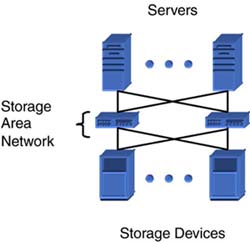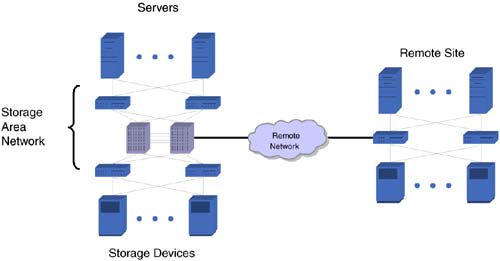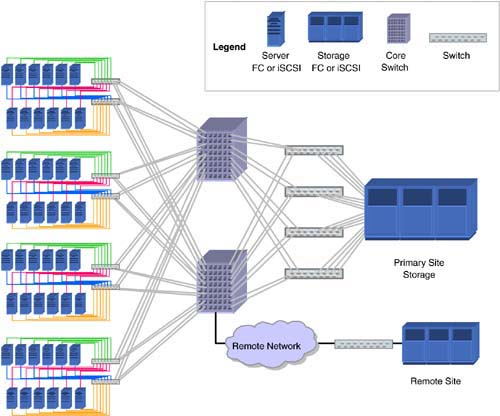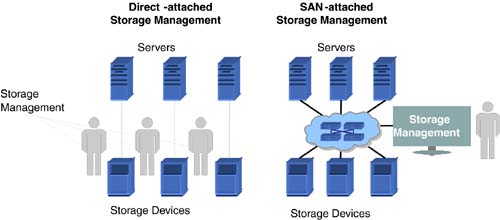5.2 Primary Defensive Strategies
| This section covers several defensive approaches to networked storage. The objective is to show how the inclusion of a network topology for storage facilitates cost savings and return on investment, primarily from the standpoint of minimizing risk. In the case of defensive strategies, we define risk both in terms of potential data loss as well as the financial and human capital risk associated with managing storage, specifically budget reduction risk and reliance on storage administrators. Defensive approaches to network storage are part of an optimized storage deployment foundation, yet in isolation cannot provide the full benefits for long- term strategic deployment. The defensive approaches covered here also lead to the additional returns of offensive approaches in the following section. 5.2.1 Data AvailabilityHigh-availability SAN topologies reduce downtime for mission-critical applications by providing fully redundant paths between server-based applications and storage. For fully redundant configurations, dual paths ensure that loss of equipment or a network connection will not affect operation of the system or application uptime. With DAS, the simplicity of the connection made achieving redundancy straightforward. On the server side, redundant host bus adapters (HBAs) could be connected to dual cables leading to dual controller ports on the storage device. Since servers and storage devices typically reside within the data center, and more frequently within one or two adjacently located racks, the risks involved with connection loss are minimal. Introducing a network to the architecture quickly doubles the number of interconnects between servers and storage, and requires more careful attention to the deployment of redundant paths. Let's take the case of a simple SAN, as shown in Figure 5-3. In this example, each server has dual HBAs that each connect to a separate SAN switch. Similarly, each storage device has dual controller ports that also connect to separate SAN switches. By zoning primary and alternate paths between the servers and storage devices, any failure in a server, HBA, SAN switch, or storage device can be overcome by using the alternate redundant equipment. There is no single point of failure in the architecture, which thereby enables maximum uptime for mission-critical server applications, keeping them running and generating revenue around the clock. Figure 5-3. Data availability through redundant paths in a simple SAN. Once in place, the basic storage network infrastructure can be easily expanded beyond a couple of switches to incorporate dozens of switches around a central core. In the case of Fibre Channel SANs, director-class switches with up to hundreds of ports are deployed in the core . These directors provide high-availability features such as hot-swappable power supplies and cooling systems, redundant control processors, interchangeable modules for a variety of interconnects, and capabilities for nondisruptive firmware upgrades. They also support features to create large, scalable fabrics such as zoning, trunking, and end-to-end configuration of the storage network. The overall design of large director-class switches addresses unplanned downtime through these high-availability features. Additional serviceability features, such as redundant memory for firmware images, and a variety of diagnostics tools to monitor the health and operation of the SAN guarantee the maximum amount of uptime for the overall configuration. Figure 5-4 shows the deployment of two director-class switches at the core of the storage network. These could be Fibre Channel directors, the more conventional approach to designing SANs. Gigabit Ethernet switches also could be used that support similar features of Fibre Channel directors, but do so using the mature platform of Ethernet and IP. This type of IP core fabric deployment is covered in the offensive strategies section on this chapter. Figure 5-4. High availability through director-class switches and scalable fabrics. Similar to the simple diagram in Figure 5-2, redundant directors ensure that any server has access to any storage device regardless of equipment failure within the configuration. Multiple directors can be trunked together using 1-Gbps or 2-Gbps Fibre Channel. Alternatively, higher-speed connections such as new 4-Gbps or 10-Gbps Fibre Channel could be used for greater performance. The previous examples covered data availability primarily from a local topology. Today's enterprises require availability that spans more than one geographic location. Fortunately, the network storage platform lends itself to such configurations, as outlined in the following sections. 5.2.2 Availability and Protection with Remote SAN TopologiesToday's around-the-clock business environment demands guaranteed data availability and protection that cannot be offered in single-site solutions. The potential for site disruption, natural or unnatural , requires that all organizations maintain remote site configurations of their mission-critical storage and applications. Once in a networked configuration, storage can be easily extended to remote sites. In the case of a pure Fibre Channel network, remote sites can be up to 10Km away with dedicated Fibre Channel connections or up to 100Km with dedicated fiber- optic extensions such as Dense Wave Division Multiplexing (DWDM). With IP networks, SANs can be extended to virtually unlimited distances. Figure 5-5 illustrates a sample remote storage configuration. Figure 5-5. Incorporating remote sites to storage networks. Through the use of clustering and storage mirroring software, the remote site serves as a guaranteed backup in the event that the primary site becomes unavailable. Applications can continue to run, and customers can continue to be served , thus avoiding costly downtime. These are the primary drivers for remote storage configurations today, which frequently fall into the disaster recovery category. However, this incomplete picture leads corporations to lose additional SAN value in not fully realizing the power of the networked platform. Recognizing that availability and protection are only first steps to optimized deployment, companies can achieve greater returns on their storage investment and benefit from longer term strategic savings. This chapter covers these options under offensive strategies. 5.2.3 Data Availability and Remote Site Storage User DiagramFigure 5-6 shows a sample configuration where IP switches are used to create a highly available core, and a remote site is connected directly to that core via an IP network. Centralization on an IP platform allows users to consolidate network technologies across local and remote topologies. Figure 5-6. Sample customer configuration with a redundant core and remote storage. 5.2.4 Budget Reduction and Human Capital ProtectionDefensive strategies go beyond data risk to address the business risks of dealing with limited budgets and constraints on human capital, specifically trained storage professionals. Almost every IT manager struggles with the "do more with less" mandate permeating corporate landscapes . But not every department has exponential storage growth requirements like the IT group . "Do more with less" combined with exponential workloads lends to precarious corporate competence. Budget reductions for IT professionals and storage managers present insurmountable obstacles with traditional storage infrastructures such as DAS. For example, with DAS, each storage device must be manually configured to work with each server. Since the storage devices typically are only available on a server-by-server basis, the configuration process can be time-consuming . Storage devices covering different models or different vendors may require specific skill sets beyond those of a single administrator. This leads to a direct relationship between the amount of storage in the overall configuration and the number of storage administrators. In fact, based on average storage growth rates, even keeping budgets at constant levels constitutes a budget reduction. Figure 5-7 shows how a SAN dramatically reduces the storage management costs associated with DAS. By networking storage devices together and providing centralized storage management, a single administrator has the ability to manage a greater amount of storage from a single console. Further, all of the required storage functions, such as backup, archiving, and consolidation, can be initiated via centralized software functions. Figure 5-7. Storage networks facilitate storage management savings. Storage networks help IT professionals grapple with escalating storage capacity and management requirements by minimizing the financial exposure to budget fluctuations. Additionally, the functionality of a storage network and the ability to automate many of the standard software functions helps IT managers and directors deal with staffing issues such as turnover and difficult-to-fill positions . By providing centralized functionality with greater automation, the entire IT department can accomplish more with less. This largely defensive strategy guarantees that user demands are met within the confines of corporate operating restrictions. |
EAN: 2147483647
Pages: 108




